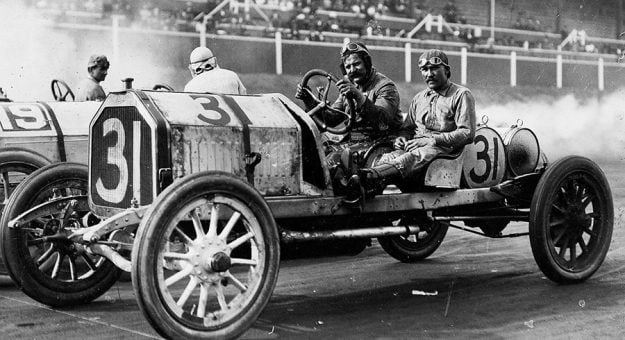Most recognize Chevrolet as one of the world’s best-selling automobile lines. Few, however, realize how tightly intertwined the beginnings of that iconic company were with racing.
Louis Joseph Chevrolet, born in a rustic Swiss village on Christmas 1878, was a teenager when the bicycle craze erupted. He was immediately captivated and his first taste of competition came on those then cutting-edge machines.
A self-taught engineer, Chevrolet displayed an aptitude for design and an entrepreneurial bent, building and selling his own bicycles at age 16. He named his creations Frontenac, after the 17th-century governor of France’s North American colonies. Later, he branded his successful line of race cars with the same name.
With the appearance of the first automobiles, Chevrolet’s interests turned automotive. His family migrated to France and he was first employed as an automotive mechanic in Paris. While in Paris, William K. Vanderbilt’s three-wheel car broke down and Chevrolet won Vanderbilt’s admiration when he repaired it after others failed.
Vanderbilt encouraged him to migrate to the U.S., asserting, “We need you there.”
Chevrolet did just that.
After being courted by several New York car companies, he accepted an offer from Fiat, a fortuitous choice as he also became a Fiat racer. Beginning as a backup, Chevrolet’s big break came when he defeated Barney Oldfield and Walter Christie at New York’s Hippodrome in 1905. That same year, he beat Christie along with Henry Ford in Cape May, N.J.
Buick wooed him away from Fiat and many more victories followed. Chevrolet gained national celebrity as one of the era’s most accomplished drivers. That attracted the attention of the millionaire founder of General Motors Corp., William C. Durant.
When corporate politics forced him out at GM, Durant attempted to capitalize on Chevrolet’s notoriety and founded Chevrolet Motor Co. with Louis in 1911.
In 1912, the first Chevrolet rolled off the assembly line. Priced at $2,150 and aimed at the luxury market, it succeeded. They sold 3,000 cars the first year and 16,000 over the next two years with profits of $1.3 million.
However, both men were headstrong and they fought furiously. The “Cigar Fight” became legendary. Durant believed an automotive executive who smoked, should smoke cigars. But Chevrolet insisted on his disarming habit of talking to clients and suppliers with a cigarette dangling precariously out of the side of his mouth.
A shouting match ensued. Chevrolet, known as impatient and quick-tempered, stomped away, yelling, “I’ve given you my name, I’ll be damned if I’m giving you my personality.”
The fight that destroyed their relationship, though, was over the company’s direction. Chevrolet, a perfectionist, only wanted to design top-of-the-line cars. Durant, instead, demanded an inexpensive car to compete with the Ford Model T.
Refusing to retreat from his principles, Chevrolet sold his shares to Durant and walked away, costing him millions of dollars.
Wasting little time, Chevrolet formed the Frontenac Motor Co. in 1915 and designed and built race cars. Over the next four years, he raced them along with his brothers Arthur and Gaston, and they proved so successful that the Monroe Automotive Co. contracted Chevrolet to build cars under its brand.
Seven Chevrolet-designed cars competed at Indianapolis in 1920 — three Frontenacs and four Monroes. Always at the forefront of development, Chevrolet used a new, lightweight material, vanadium, for the car’s steering arms.
However, the pieces were not properly heat treated and one by one they failed until only Gaston’s car remained. He won the 500 at a record-breaking speed.
Louis Chevrolet’s fame as a designer provided another opportunity to manufacture a passenger car. Backed by the Stutz Motor Co., 1,500 workers assembled the Frontenac in a new plant. It was a showpiece of the motor industry, but an economic downturn drove the company into bankruptcy.
Chevrolet turned to aviation, designing and building the Chevrolair aircraft engine. He’d secured several contracts but lost them in the 1929 stock market crash.
Nearly penniless, Louis Chevrolet returned to Detroit and, ironically, worked as a mechanic in the Chevrolet plant until his death in 1941.
